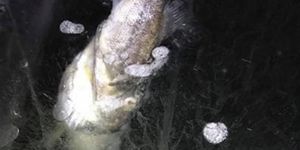The Komodo's toxic blood
As if Komodo dragons weren’t cool enough, a new study reports that these guys have antimicrobial proteins in their blood!
Able to grow to nearly 10 feet long, Komodo dragons are the world’s largest lizards. They are native to a handful of Indonesian islands, one being the island of Komodo. I think the most impressive thing about these lizards is their ability to hunt and kill large prey - we’re talking deer and even buffalo.
The Komodo’s teeth are serrated. As a result, hunks of flesh tend to cling to their teeth, promoting the growth of bacteria. Some of these bacteria are harmless, but many are actually pathogenic. This means that a Komodo bite will easily become infected (assuming you actually survive the attack). But, what about the lizard itself? How does it safely tote around all those nasty bacteria in its mouth without becoming sick?
This question has puzzled researcher for some time, but a study out of George Mason University reports that Komodo dragons have antimicrobial proteins in their blood. This may be one way that these lizards keep themselves safe from infections.
Most all animals produce some sort of antimicrobial proteins, and the researchers were particularly interested in a type called cationic antimicrobial peptides (CAMPS).
To collect and identify CAMPS from Komodo dragon blood, the group incubated the blood with a negatively charged hydrogel. This negatively charged gel captured the positively charged CAMPS. From there, they used mass spectrometry to identify individual CAMPS.
They discovered 48 new CAMPS, most of which were derived from histone proteins. They went on to test whether 8 of these CAMPS could kill Pseudomonas aeruginosa or Staphylococcus aureus (compared to human CAMP LL-37). They found that 7 of the CAMPS were able to kill both P. aeruginosa and S. aureus - meaning that they are effective against Gram-negative and Gram-positive strains. The remaining CAMP, however, was only able to kill P. aeruginosa.
Notably, all but one of the 48 CAMPS that the group identified are unique to Komodo dragons - they are not like any other antimicrobial peptide made by reptiles. Also interesting is the fact that these CAMPS appear to be derived from histone proteins. We usually think about histones being involved in regulating gene expression, but they also have antibacterial properties.
Fish, frogs, shrimp, mice, and humans actually all make antimicrobial histones. In humans, a peptide derived from histone H1 is produced in the gut, and histones H2A and H2B are able to kill E. coli.
Not only are these new findings pretty cool, this information may help researchers design new antibiotics to help tackle antibiotic resistance.
Sources: Journal of Proteome Research, EurekAlert, Smithsonian National Zoo









